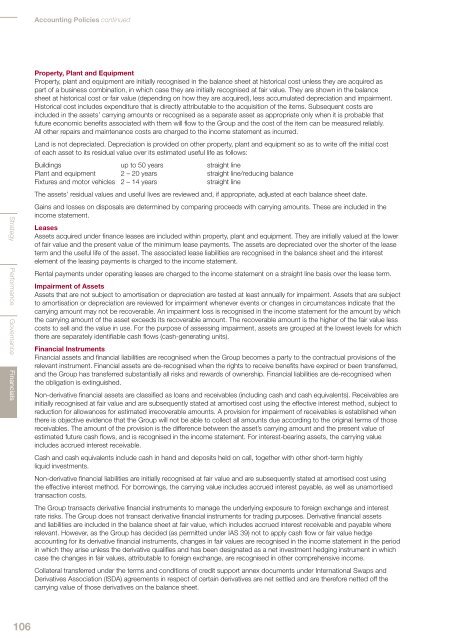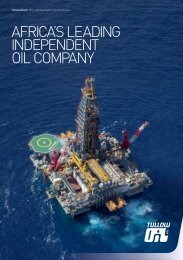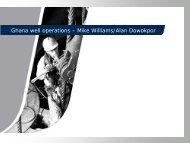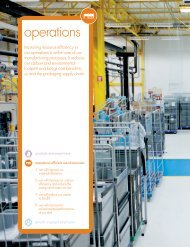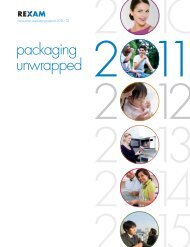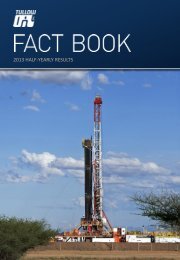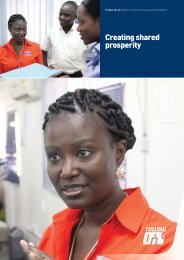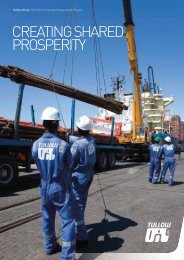Accounting Policies continuedStrategy Performance Governance FinancialsProperty, Plant and EquipmentProperty, plant and equipment are initially recognised in the balance sheet at historical cost unless they are acquired aspart of a business combination, in which case they are initially recognised at fair value. They are shown in the balancesheet at historical cost or fair value (depending on how they are acquired), less accumulated depreciation and impairment.Historical cost includes expenditure that is directly attributable to the acquisition of the items. Subsequent costs areincluded in the assets’ carrying amounts or recognised as a separate asset as appropriate only when it is probable thatfuture economic benefits associated with them will flow to the <strong>Group</strong> and the cost of the item can be measured reliably.All other repairs and maintenance costs are charged to the income statement as incurred.Land is not depreciated. Depreciation is provided on other property, plant and equipment so as to write off the initial costof each asset to its residual value over its estimated useful life as follows:Buildings up to 50 years straight linePlant and equipment 2 – 20 years straight line/reducing balanceFixtures and motor vehicles 2 – 14 yearsstraight lineThe assets’ residual values and useful lives are reviewed and, if appropriate, adjusted at each balance sheet date.Gains and losses on disposals are determined by comparing proceeds with carrying amounts. These are included in theincome statement.LeasesAssets acquired under finance leases are included within property, plant and equipment. They are initially valued at the lowerof fair value and the present value of the minimum lease payments. The assets are depreciated over the shorter of the leaseterm and the useful life of the asset. The associated lease liabilities are recognised in the balance sheet and the interestelement of the leasing payments is charged to the income statement.Rental payments under operating leases are charged to the income statement on a straight line basis over the lease term.Impairment of AssetsAssets that are not subject to amortisation or depreciation are tested at least annually for impairment. Assets that are subjectto amortisation or depreciation are reviewed for impairment whenever events or changes in circumstances indicate that thecarrying amount may not be recoverable. An impairment loss is recognised in the income statement for the amount by whichthe carrying amount of the asset exceeds its recoverable amount. The recoverable amount is the higher of the fair value lesscosts to sell and the value in use. For the purpose of assessing impairment, assets are grouped at the lowest levels for whichthere are separately identifiable cash flows (cash-generating units).Financial InstrumentsFinancial assets and financial liabilities are recognised when the <strong>Group</strong> becomes a party to the contractual provisions of therelevant instrument. Financial assets are de-recognised when the rights to receive benefits have expired or been transferred,and the <strong>Group</strong> has transferred substantially all risks and rewards of ownership. Financial liabilities are de-recognised whenthe obligation is extinguished.Non-derivative financial assets are classified as loans and receivables (including cash and cash equivalents). Receivables areinitially recognised at fair value and are subsequently stated at amortised cost using the effective interest method, subject toreduction for allowances for estimated irrecoverable amounts. A provision for impairment of receivables is established whenthere is objective evidence that the <strong>Group</strong> will not be able to collect all amounts due according to the original terms of thosereceivables. The amount of the provision is the difference between the asset’s carrying amount and the present value ofestimated future cash flows, and is recognised in the income statement. For interest-bearing assets, the carrying valueincludes accrued interest receivable.Cash and cash equivalents include cash in hand and deposits held on call, together with other short-term highlyliquid investments.Non-derivative financial liabilities are initially recognised at fair value and are subsequently stated at amortised cost usingthe effective interest method. For borrowings, the carrying value includes accrued interest payable, as well as unamortisedtransaction costs.The <strong>Group</strong> transacts derivative financial instruments to manage the underlying exposure to foreign exchange and interestrate risks. The <strong>Group</strong> does not transact derivative financial instruments for trading purposes. Derivative financial assetsand liabilities are included in the balance sheet at fair value, which includes accrued interest receivable and payable whererelevant. However, as the <strong>Group</strong> has decided (as permitted under IAS 39) not to apply cash flow or fair value hedgeaccounting for its derivative financial instruments, changes in fair values are recognised in the income statement in the periodin which they arise unless the derivative qualifies and has been designated as a net investment hedging instrument in whichcase the changes in fair values, attributable to foreign exchange, are recognised in other comprehensive income.Collateral transferred under the terms and conditions of credit support annex documents under International Swaps andDerivatives Association (ISDA) agreements in respect of certain derivatives are net settled and are therefore netted off thecarrying value of those derivatives on the balance sheet.106
InventoriesInventories are stated at the lower of cost and net realisable value. Cost is determined using the first-in, first-out (FIFO)method. The cost of finished goods and work in progress comprises raw materials, direct labour, other direct costs andrelated production overheads (based on normal operating capacity) but excludes borrowing costs. Net realisable value isthe estimated selling price in the ordinary course of business, less the estimated costs of completion and selling expenses.Leaf tobacco inventory which has an operating cycle that exceeds twelve months is classified as a current asset, consistentwith recognised industry practice.ProvisionsA provision is recognised in the balance sheet when the <strong>Group</strong> has a legal or constructive obligation as a result of a pastevent, it is more likely than not that an outflow of resources will be required to settle that obligation, and a reliable estimateof the amount can be made.A provision for restructuring is recognised when the <strong>Group</strong> has approved a detailed formal restructuring plan, and therestructuring has either commenced or has been publicly announced, and it is more likely than not that the plan will beimplemented, and the amount required to settle any obligations arising can be reliably estimated. Future operating lossesare not provided for.Where there are a number of similar obligations, the likelihood that an outflow will be required in settlement is determined byconsidering the class of obligations as a whole. A provision is recognised even if the likelihood of an outflow with respect toany one item included in the same class of obligations may be small.Retirement Benefit SchemesThe <strong>Group</strong> operates a number of retirement benefit schemes for its employees, including both defined benefit and definedcontribution schemes.Under a defined benefit scheme, the amount of retirement benefit that will be received by an employee is defined withrespect to period of service and final salary. The amount recognised in the balance sheet is the difference between thepresent value of the defined benefit obligation at the balance sheet date and the fair value of the scheme assets. The definedbenefit obligation is calculated annually by independent actuaries using the projected unit credit method. The present valueof the defined benefit obligation is determined by discounting the estimated future cash outflows.The service cost of providing retirement benefits to employees during the year is charged to operating profit.Past service costs are recognised immediately in income, unless the changes to the pension plan are conditional on theemployees remaining in service for a specified period of time (the vesting period). In this case, the past service costs areamortised on a straight line basis over the average vesting period. All actuarial gains and losses, including differencesbetween actual and expected returns on assets and differences that arise as a result of changes in actuarial assumptions,are recognised immediately in full in the statement of comprehensive income for the period in which they arise.A credit representing the expected return on plan assets of the retirement benefit schemes during the year is included withinnet finance costs. This is based on the market value of the assets of the schemes at the start of the financial year. A chargeis also made within net finance costs for the expected increase in the present value of the liabilities of the retirement benefitschemes during the year arising from the schemes being one year closer to payment.For defined contribution schemes, the <strong>Group</strong> pays a defined contribution to the scheme. There are no further paymentobligations once these contributions have been paid. Such contributions are recognised as an employee benefit expensewhen they are due. Any prepaid contributions are recognised as an asset to the extent that a cash refund or reduction infuture payments is available.Share-Based PaymentsThe <strong>Group</strong> applies the requirements of IFRS 2 Share-Based Payment Transactions to both equity-settled and cash-settledshare-based employee compensation schemes. The majority of the <strong>Group</strong>’s schemes are equity-settled.Equity-settled share-based payments are measured at fair value at the date of grant and are expensed over the vestingperiod, based on the number of instruments that are expected to vest. For plans where vesting conditions are based on totalshareholder returns, the fair value at the date of grant reflects these conditions. Earnings per share vesting conditions arereflected in the estimate of awards that will eventually vest. For cash-settled share-based payments, a liability equal to theportion of the services received is recognised at its current fair value at each balance sheet date. Where applicable the <strong>Group</strong>recognises the impact of revisions to original estimates in the income statement, with a corresponding adjustment to equityfor equity-settled schemes and current liabilities for cash-settled schemes. Fair values are measured using appropriatevaluation models, taking into account the terms and conditions of the awards.The <strong>Group</strong> funds the purchase of shares to satisfy rights to shares arising under share-based employee compensationschemes. Shares acquired to satisfy those rights are held in Employee Share Ownership Trusts. On consolidation, theseshares are accounted for as a deduction from equity attributable to owners of the parent. When the rights are exercised,equity is increased by the amount of any proceeds received by the Employee Share Ownership Trusts.107
- Page 1 and 2:
Imperial Tobacco Group PLCAnnual Re
- Page 3 and 4:
…to deliver sustainableshareholde
- Page 5 and 6:
Operational HighlightsDelivering Su
- Page 7 and 8:
and product portfolio to evolving c
- Page 9 and 10:
In this section9 Strategic Review10
- Page 11 and 12:
Our StrategyWe are focused on deliv
- Page 13 and 14:
Total Tobacco5 % Our Powerful Brand
- Page 15 and 16:
Our global strategic cigarette bran
- Page 17 and 18:
Our global team is fully aligned be
- Page 19 and 20:
Satisfying consumers and aligning o
- Page 21 and 22:
We are a responsive business with s
- Page 23 and 24:
Operating responsibly, combined wit
- Page 25 and 26:
Our growth drivers of sales growth,
- Page 27 and 28:
Principal Risks and UncertaintiesA
- Page 29 and 30:
Competition LawOverviewWe take comp
- Page 31 and 32:
Reconciliation of Adjusted Performa
- Page 33 and 34:
Key Performance Indicators (KPIs) 1
- Page 35 and 36:
Lambert & Butler and Richmond remai
- Page 37 and 38:
Within this the travel retail marke
- Page 39 and 40:
OutlookThe strength of our portfoli
- Page 41 and 42:
Blondes. In the Middle East, we aga
- Page 43 and 44:
Corporate ResponsibilityOur Corpora
- Page 45 and 46:
Corporate Responsibility and our St
- Page 47 and 48:
We have revised our IMS and employe
- Page 49 and 50:
Environmental Performance 1Absolute
- Page 51 and 52:
across the business. More informati
- Page 53 and 54:
Supplier RelationshipsOur main supp
- Page 55 and 56:
Non-financial performance indicator
- Page 57 and 58: “High standards of corporategover
- Page 59 and 60: 5. Pierre Jungels, CBE (HON), PHD,
- Page 61 and 62: Management and Corporate StructureB
- Page 63 and 64: Meetings of the Board, Board Commit
- Page 65 and 66: and supplemented by our Non-Executi
- Page 67 and 68: 6 Performance evaluation: How do we
- Page 69 and 70: The Board recognises that we operat
- Page 71 and 72: Assurance process for financial rep
- Page 73 and 74: - receiving reports from, and quest
- Page 75 and 76: Directors’ Report: Other Informat
- Page 77 and 78: - state whether IFRSs as adopted by
- Page 79 and 80: We understand that a purported coll
- Page 81 and 82: This Report covers the following:1
- Page 83 and 84: 2 Directors’ Emoluments for the Y
- Page 85 and 86: Directors’ Interests in Ordinary
- Page 87 and 88: Executive Directors’ Service Agre
- Page 89 and 90: When setting base salary the Remune
- Page 91 and 92: First ElementFifty per cent of the
- Page 93 and 94: In respect of the October 2007 - Oc
- Page 95 and 96: Any annual bonus earned up to 100 p
- Page 97 and 98: Benefit Trusts have also been provi
- Page 99 and 100: Independent Auditors’ Reportto th
- Page 101 and 102: Consolidated Statement ofComprehens
- Page 103 and 104: Consolidated Statement of Changes i
- Page 105 and 106: Accounting PoliciesBasis of Prepara
- Page 107: Duty and Similar ItemsDuty and simi
- Page 111 and 112: Restructuring CostsSignificant one-
- Page 113 and 114: Property, Plant and Equipment and I
- Page 115 and 116: Tobacco net revenue£ million 2010
- Page 117 and 118: 3 Restructuring Costs£ million 201
- Page 119 and 120: Factors affecting the tax charge fo
- Page 121 and 122: 9 Intangible Assets2010£ million G
- Page 123 and 124: 10 Property, Plant and Equipment201
- Page 125 and 126: 13 Trade and Other Receivables2010
- Page 127 and 128: Sensitivity analysisIFRS 7 requires
- Page 129 and 130: At 30 September 2009Balance sheetam
- Page 131 and 132: (iii) Currency analysis and effecti
- Page 133 and 134: (iv) Derivative financial instrumen
- Page 135 and 136: Matures in financial year ending in
- Page 137 and 138: The following tables are provided i
- Page 139 and 140: Matures in financial year ending in
- Page 141 and 142: (vi) Hedge of net investments in fo
- Page 143 and 144: 18 Retirement Benefit SchemesThe Gr
- Page 145 and 146: Assumptions regarding future mortal
- Page 147 and 148: 21 Share SchemesThe Group recognise
- Page 149 and 150: Year from 1 October 2008 to 30 Sept
- Page 151 and 152: 23 CommitmentsCapital commitments£
- Page 153 and 154: 27 Reconciliation of Cash Flow to M
- Page 155 and 156: Imperial Tobacco Group PLC Balance
- Page 157 and 158: (iii) Debtors: Amounts Falling Due
- Page 159 and 160:
Principal SubsidiariesThe principal
- Page 161 and 162:
Shareholder InformationRegistered O
- Page 163 and 164:
IndexAAccounting Policies 103Acquis


